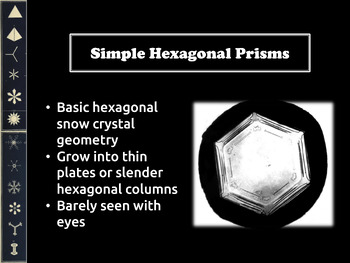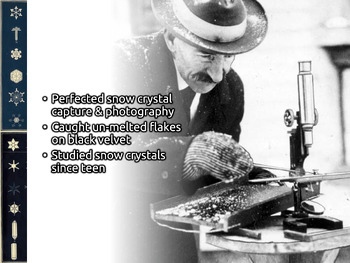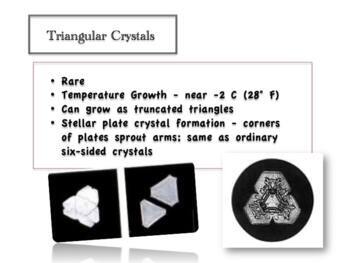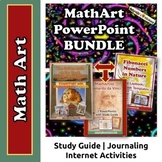Wilson Bentley PowerPoint | Snowflake Unit Study
- Zip
- Internet Activities
Also included in
- Math With Art is NatureGlo's MathArt Animated PowerPoint BUNDLE with student study guides and Internet Activities! This product is a remarkable growing culmination of 17 years of private school and online homeschool teaching. My homeschool parents tell me that MathArt is the missing link in modern dPrice $155.50Original Price $189.00Save $33.50
Description
This study features the physics of snow crystal development, past and present snow physicists, and famed snow crystal photographer, "Snowflake" Bentley and his remarkable photographic genius of snow crystals using an old bellows camera. Students look at the varieties of snowflakes and their geometry. Check out one of nature's most astonishing miracles and wonders in science and mathematics.
The wonder of snow on a microscopic level is its own world.
Students draw and take notes in the activity guide and a suggested journal. They can learn to design their own virtual snowflakes and choose from varying projects and activities from the study guide and MathArt class Website.
What's included:
- 1 Quick Start Guide
- 3 PowerPoints
- 19-page activity guide
- Web resources: projects, activities, videos
Subjects covered:
- Math - basic geometry of snowflakes
- Physics of snow crystal formation
- History of famous snow physicists and photoraphers
- Science - snowflake formation
- Art - snowflake projects and activities given in web resources
- Technology - use in photographing snowflakes
Questions addressed:
- How do snow crystals form?
- How many different kinds are there?
- Can scientists make them in the lab?
OTHER RELATED TITLES:
PowerPoint & Activity Guide: The Golden Number and Fibonacci PowerPoint
The Golden Ratio & the Great Pyramid Unit Study
LOOKING FOR A FULL YEAR OF MathArt and SCIENCE PLUS SUMMER eLEARNING?
Also Check out:
********************
MathArt Full Year Curriculum (great for grades 3 - 8)
I'd love to stay connected with you! Connect with me now on:
*******************************************************************************
NatureGlo's eScience YouTube Channel
NatureGlo's eScience Pinterest
Got questions? Email me at natureglosescience@gmail.com
Happy learning adventures!
Gloria aka NatureGlo






